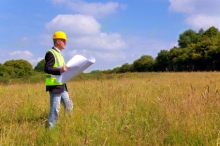Civil Engineering Tip: Go Play in the Rain!
Video
My latest bit of unsolicited advice for civil engineers and other land development professionals is simple: go play in the rain. Alternatively, if you feel you have gotten too old (never!) to play in the rain, at least get out and watch it. The typical human tendency is to stay inside when it rains, and going out to check on the site of your proposed, ongoing, or completed construction project is probably one of the last things that you want to do, but it can be a tremendous learning experience.

With current technology including more precise surveys, aerial photography, GPS, GIS, you name it, designing projects without spending any real time on the site has become increasingly easier. More often than not, when the project is done the only time we visit the site is when a problem occurs. I confess that I used to fall into this habit. Lately, however, when we get a significant (0.5" – 1" or more) rainfall, I try to check out some of my projects that face stormwater challenges. My wife finds this behavior quite amusing, but it has provided me with some information on stormwater design and basic hydrology that I couldn't get otherwise. Here are some of the rather simple but powerful insights that I have gained from standing in the rain looking like an idiot.
Lawns and other areas that we often consider pervious aren't. It's common practice to assign lower curve numbers or runoff coefficients to lawn and/or grassed areas, a practice based on a reasonable assumption to make. However, I think that more often than not these areas create more runoff than we realize. You have only to stand in the rain in a residential subdivision watching the runoff from lawns to realize that, although these areas are certainly not as impervious as pavement or roofs, they certainly produce significant runoff.
Topographical surveys miss a lot. Topographical surveys are an essential part of the design and planning process and are a great tool for determining runoff patterns, but they can't replace some time on the site, especially in the rain. A few minutes in the rain will usually reveal small nuances in the topography and runoff patterns that even a good topographical survey will miss – and those nuances can have a major impact on the stormwater performance of your site.
Better pay attention to your erosion controls. In my experience erosion controls are usually based on compliance and not performance. That is to say that they are designed and installed to meet the minimum standard required by law and avoid fines. Unfortunately, the result of this practice is often underperforming erosion controls and a quick visit to the site during a heavy rain will reveal this.
Detention ponds rarely (never?) mimic pre-development hydrology. Have you ever watched the discharge from a detention pond during and after a rainfall? It almost never resembles the pre-development hydrology. Most detention ponds are designed to meet municipal standards for discharge, which usually focus on flood control and do nothing else to match pre-development hydrology. Never is this more clear than when you watch the discharge from a pond during and after a storm.
These are all simple points that can be easily overlooked from the comfort of your desk. And while I think most engineers inherently know these things, I believe that it's worth while to get out in the rain and see it for yourself first hand. So go ahead, be an idiot like me and go play in the rain!
Civil Engineering Tip: Go Play in the Rain! was originally published on The Green Civil Engineer

Bob Faulhaber
Bob is a registered professional engineer in TN with a master’s degree in Civil Engineering and over ten years of experience in project planning, design and management. Bob was on the forefront of the green building movement and was ahead of the curve in obtaining LEED accreditation in 2005. He is passionate about sustainability and lectures and writes about green buildings and sustainability in an effort to educate the design community and the general public.
Websites: Faulhaber Engineering & Sustainability | The Green Civil Engineer


